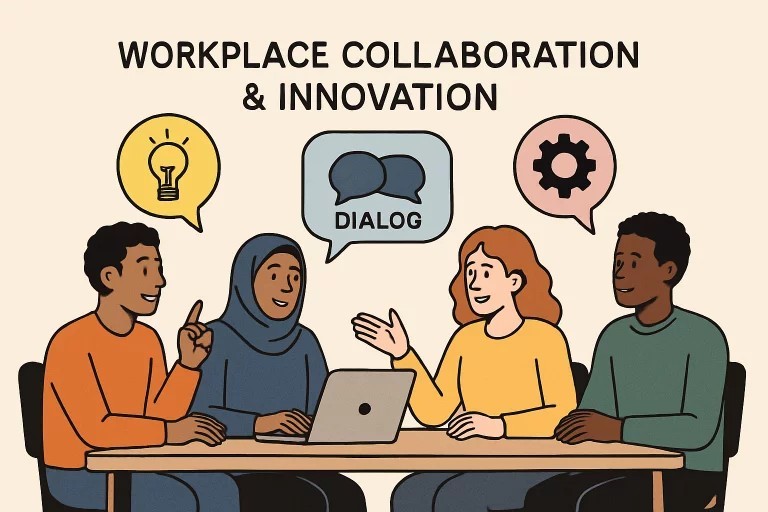The Role of Diversity in the Workplace: Driving Innovation and Building Collaboration

Diversity in the workplace is more than a surface-level commitment; it’s a driver of innovation and strength. Modern organizations thrive when they embrace the varied perspectives and experiences within their workforce.
Table of Contents
Introduction
When defining diversity in the workplace, it involves recognizing the presence of differences among individuals in terms of race, gender, age, ethnicity, sexual orientation, ability, and, importantly, thought. It also encompasses diverse perspectives, problem-solving approaches, and communication styles.
As businesses face rapid digital changes and global challenges, adaptability has become essential. Inclusion empowers employees to share their ideas, challenge norms, and contribute to meaningful goals. In turn, this environment supports sustainable growth, collaboration, and a lasting competitive edge.
Enhancing Innovation Through Diverse Perspectives
Innovation flourishes when people with diverse backgrounds, experiences, and skills collaborate. Each individual brings a unique lens, offering new angles for tackling challenges and generating creative ideas.
This diversity dismantles echo chambers and encourages fresh, unconventional thinking. Research shows a strong correlation between diverse leadership teams and increased profitability and innovation. Companies with diverse workforces are also better equipped to reach new markets and develop products that cater to the needs of a broad consumer base.
Business leaders are increasingly recognizing the importance of diversity as essential to long-term innovation and success.
Improving Decision-Making and Problem-Solving
Diverse teams are better equipped to make informed and effective decisions. Their range of perspectives helps organizations avoid groupthink and uncover blind spots.
Inclusive teams tend to question assumptions, consider alternative viewpoints, and evaluate multiple solutions to find the best approach. Studies confirm that organizations with diverse management report significantly higher innovation revenue.
This diversity enhances strategic execution and cultivates shared accountability. Ultimately, diverse thinking fosters agility, resilience, and smarter outcomes in a fast-changing business environment.
Fostering Collaboration and Employee Engagement
Inclusion transforms diversity from a statistic into a source of strength. When employees feel psychologically safe, they are more likely to share ideas, collaborate openly, and perform at their best—this sense of belonging fosters mutual respect and trust throughout the organization.
As highlighted in a Forbes article, effective collaboration driven by inclusion is crucial to high employee engagement and long-term success. As a result, teams become more innovative, engaged, and productive. Inclusive workplaces also experience lower stress levels, reduced absenteeism, and better employee retention.
Attracting and Retaining Top Talent
Modern job seekers prioritize diversity, equity, and inclusion when evaluating employers. Companies that demonstrate a real commitment to these values are more attractive to high-quality candidates from diverse backgrounds.
According to Business News Daily, creating an inclusive workplace culture is a powerful way to attract skilled workers who seek more than just a paycheck, as they look for purpose and a sense of belonging. An inclusive culture not only attracts top talent but also encourages them to stay.
When employees feel valued and supported, they’re more loyal and engaged. This leads to a more stable and high-performing workforce as well as a stronger organizational reputation.
See also: Top Benefits of Portable Dual Battery Packs for Camping
Implementing Effective Diversity and Inclusion Strategies
Building a truly diverse and inclusive workplace requires intentional, strategic action across all levels of an organization. Practical DEI efforts begin with clear goals, strong leadership, inclusive hiring and promotion practices, and a culture of accountability.
- Leadership Commitment: Senior leaders must actively champion diversity, setting clear expectations, allocating resources, and tracking progress to embed inclusivity into the organization’s values.
- Inclusive Recruitment and Advancement: Companies must broaden their talent pipelines and ensure fair opportunities for advancement by removing biases from hiring and promotion processes.
- Ongoing Training and Accountability: Continuous education on bias and inclusion, combined with employee feedback and progress tracking, enables organizations to adapt and foster a culture where everyone can succeed.
Conclusion
Embracing diversity in the workplace represents more than a fleeting trend; it is a long-term, strategic investment in the resilience, creativity, and overall success of an organization.
By making diversity and inclusion foundational principles, businesses gain access to broader perspectives, make sharper decisions, inspire deeper collaboration, and foster an engaged and dedicated workforce.
As the compelling data and case studies illustrate, investing in diversity is both an ethical choice and a powerful driver of competitive advantage and innovation for the modern age. For organizations seeking sustainable success, the time to champion diversity is now, through conscious effort and unwavering commitment.



